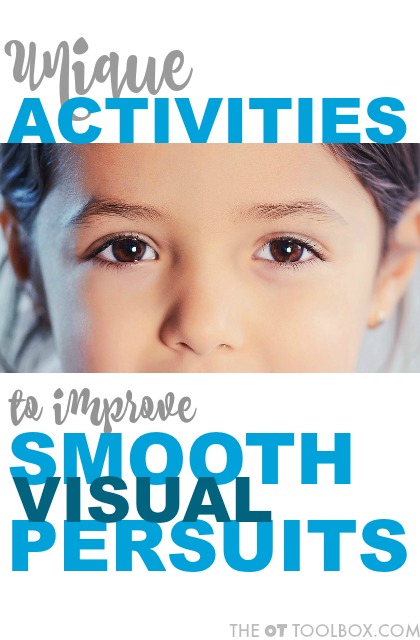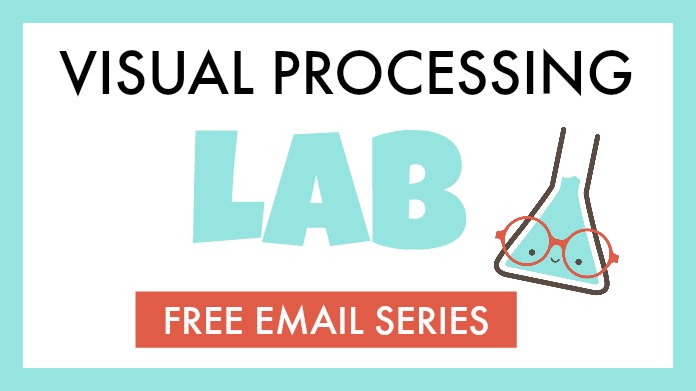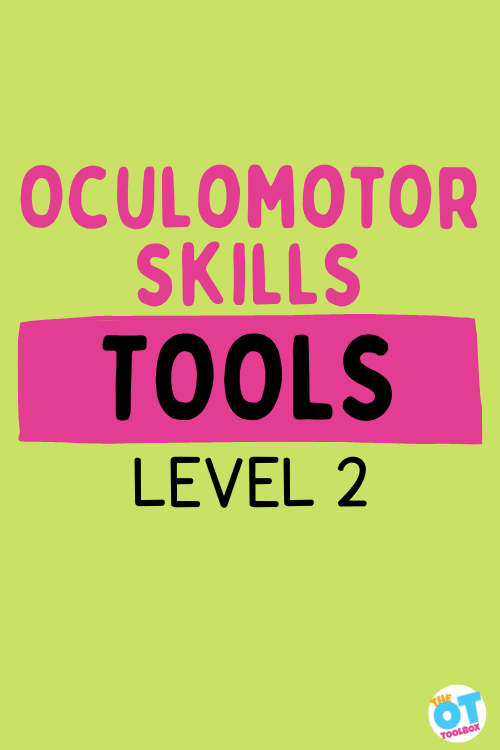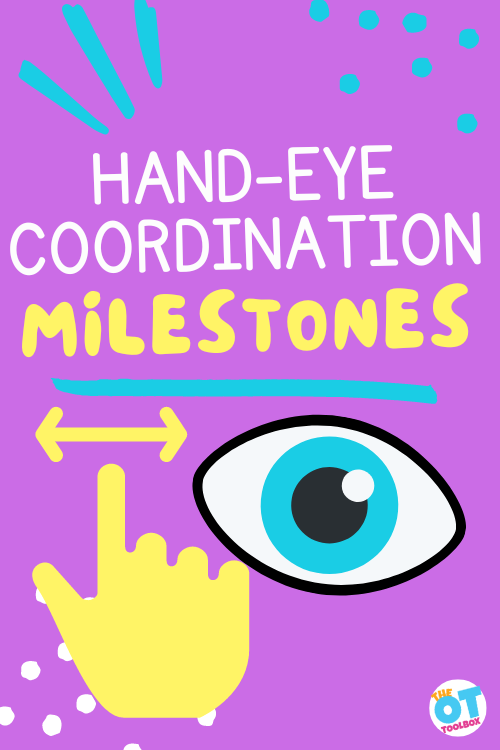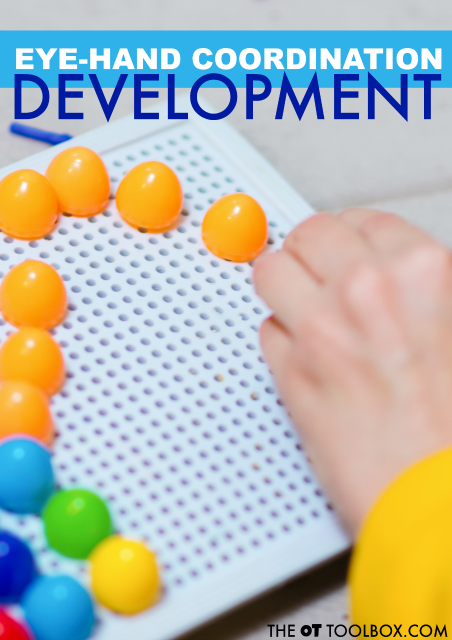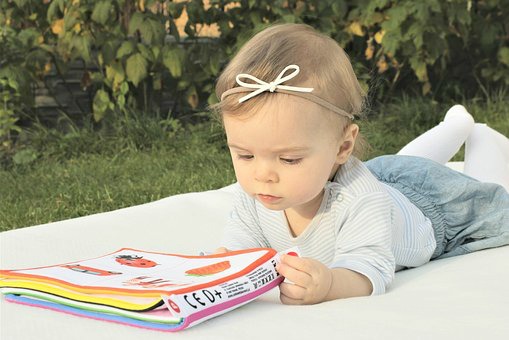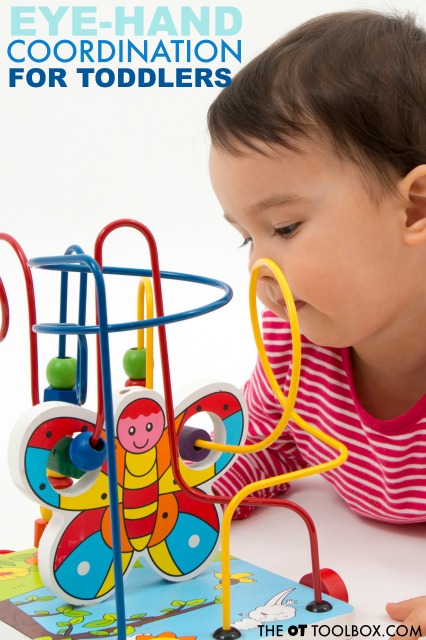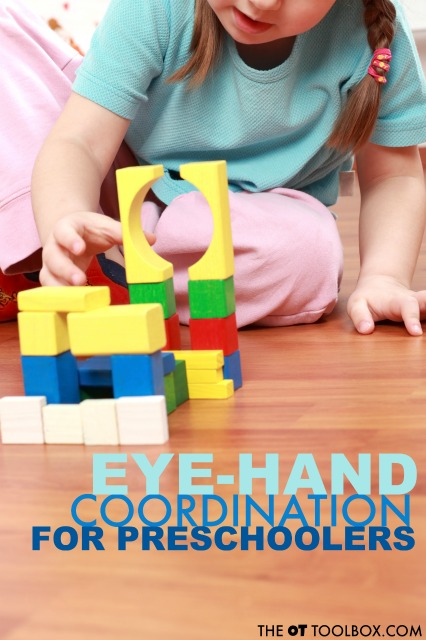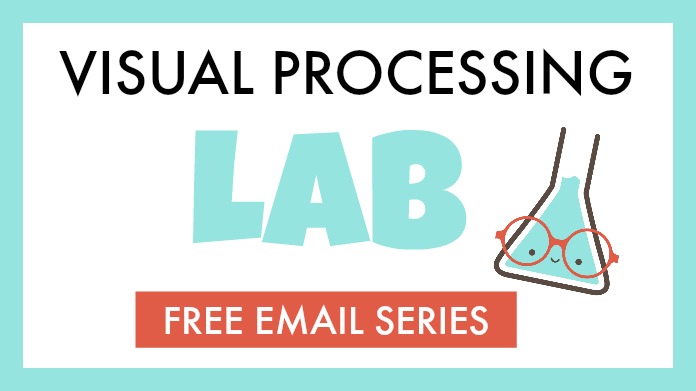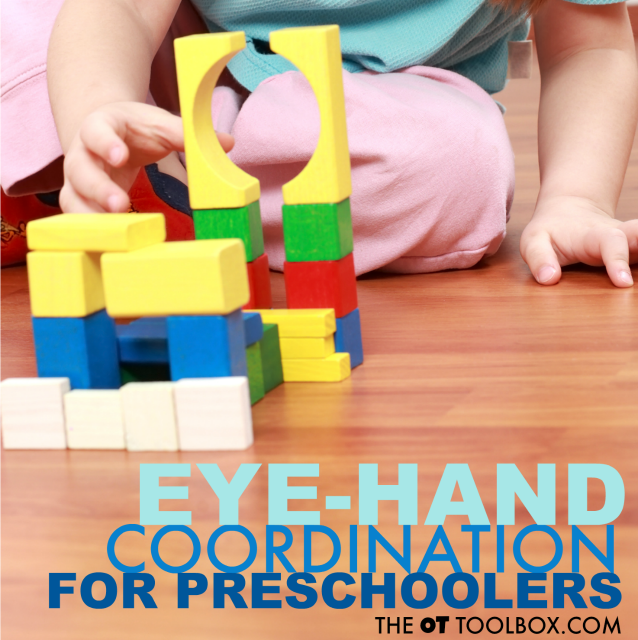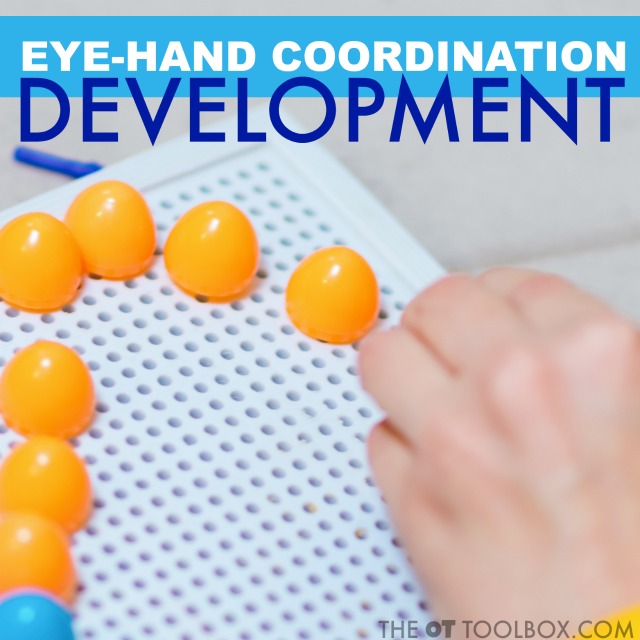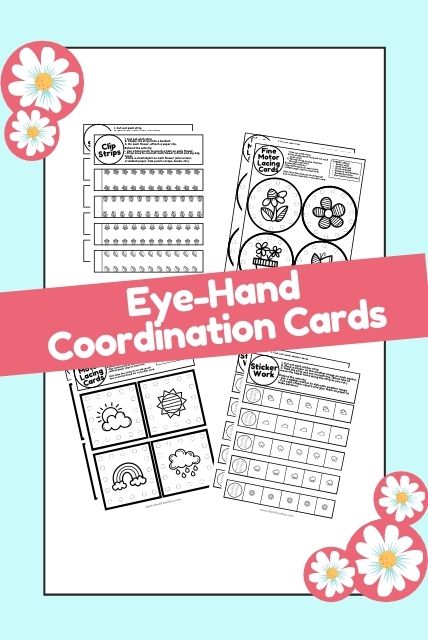For our kids who are challenged to visually observe their environment, or who struggle to demonstrate visual tracking in reading or other learning experiences, activities designed to promote smooth pursuits and eye movement can be helpful. The visual activities listed here can be helpful in addressing the smooth pursuits of visual input. Visual pursuits or tacking is an oculomotor skill that is necessary part of visual processing. Read on for various eye exercise that can be done in fun ways as a part of occupational therapy geared toward visual processing skills.
Activities to improve smooth visual pursuits
There are several activities to improve smooth visual pursuits that are used in occupational therapy to target smooth pursuits of the eyes. These smooth pursuit exercises are typically fostered through play, especially in occupational therapy interventions.
Below, you’ll find ocular pursuit activities, but first, let’s cover what visual pursuits are and how they impact a child’s learning.
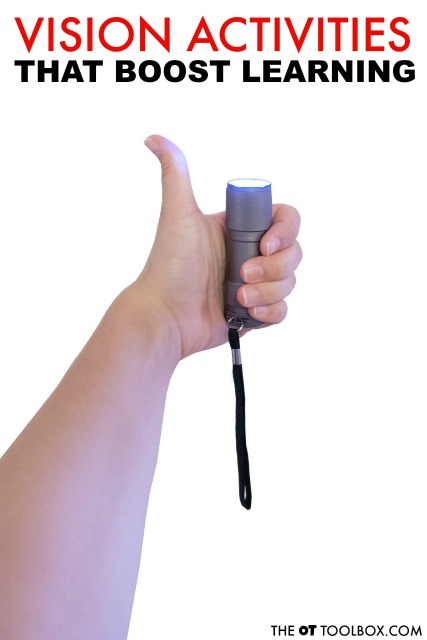
What are visual pursuits?
Visual pursuits are another term for visual tracking. Visual tracking is an oculomotor skill that is essential for learning, reading, and so many tasks we perform.
Smooth visual pursuits refer to the eye movements that enable us to track moving objects smoothly and accurately with our gaze. It’s the eye following a moving target through coordinated motion of the eye muscles.
When we watch a moving object, follow a moving object with our eyes, or follow a moving ball, our eyes move smoothly to follow the visual input. This allows us to maintain visual focus on the object as it moves. We can use that visual information to understand how fast and far the item is moving based on the object’s trajectory, speed, and direction.
Here are more information about visual tracking activities. You will also love checking out these activities to improve visual tracking.
Visual processing skills have a huge impact on learning. In fact, it is one of the visual skills that can impact learning in a way that isn’t always directly observable.
Visual skills like visual tracking, or smooth visual pursuits are a visual processing skill that allow us to perceive and retrieve visual information. This is an essential part of reading and learning.
These skills may be covered by a behavioral optometrist or developmental optometrist.
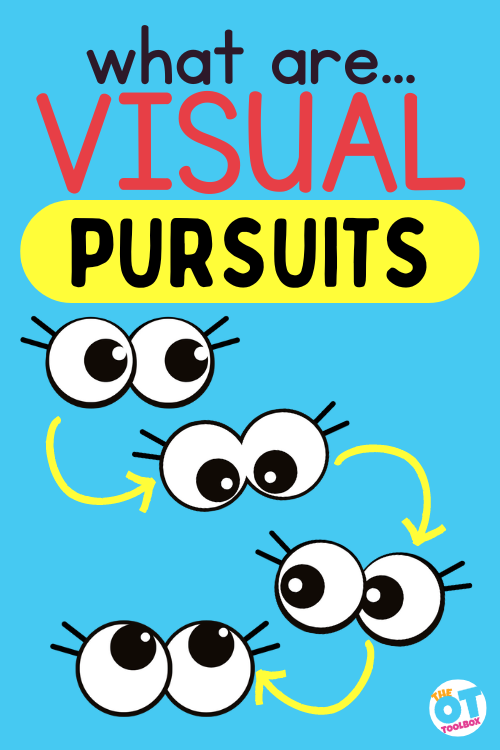
Want to learn more about HOW visual pursuits and other aspects of visual processing impact learning (in a really big way)? Scroll below to join our free visual processing lab. It’s a 3 day email series where you will learn SO much about visual processing and how it impacts everything, but especially learning and cognitive skills.
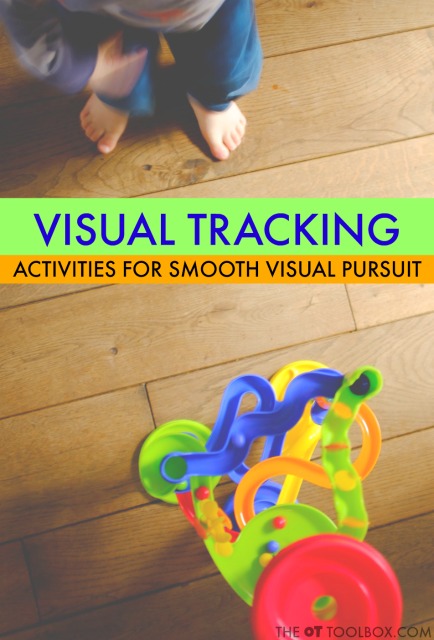
Activities to improve visual pursuits
These visual tracking activities are easy and creative ways to work on eye movement and smooth eye movements. Kids can perform these activities as part of a therapy program and while working on functional skills within an occupation.
1. Relaxing breathing eye stretches- This visual tracking activity is a way to work on smooth pursuits in a very mindful way. Just like yoga brings awareness to the body and a sense of being present, this eye stretch activity is a great way to calm a class during a busy school day.
Combine slow and deep breathing with deliberate eye movements. Kids can watch and follow directions to take deep breaths combined with slowly looking in a single direction. As they look up and breath or look to the left and breath, kids can even use this activity as a coping strategy.
Try these yoga activities:
2. Flashlight Tag- Use a flashlight to help kids follow a target in various directions. Try a circle, uppercase letter “H”, triangle, straight/diagonal lines, etc. To make this activity more fun, try adding a deflated balloon to the top of the flashlight. Encourage kids to keep their face steady as they use just the eyes to follow the light.
3. Craft Stick Puppets- Create small craft stick characters puppets to make a visual cue as a visual prompt for follow movement patterns. These barnyard animal puppets make a great DIY puppet tool for a visual pursuit and tracking activity.
This pirate puppet is one idea that builds fine motor skills, too.
4. Marble run activities- There are many marble run products on the market that provide an opportunity for improving smooth pursuit of the eyes. Here are DIY marble run activities that make a great activity in themselves for kids.
We love to add slow moving items to marble run games too, to provide a slower object for visually tracking, encouraging smooth pursuits of the eyes. Encourage kids to keep their face steady while using their eyes only to watch the item fall through the marble run.
Try these marble run ideas:
- Magnetic marble run
- Paper tube marble run
- Marble run with jingle bells
- Marble run on a water table
- Oobleck on the marble run
5. Roll a ball- Roll a ball up a slanted surface and ask the child to keep their eyes on the ball! Some ideas include creating a sloped surface with a poster board and books.
Simply roll a small ball slowly up the ramp and kids can watch the ball as it rolls. Also try having the child to sit in front of the ramp and be in charge of rolling the ball. Mark off where the ball should reach and stop so the child works on graded movement at the same time.
Sitting in front of the ramp encourages visual convergence and binocular fusion as well. This activity works well with a large ball such as a kick ball and a sidewalk ramp, too.
This baby brain building activity list has more ideas, too.
6. Double Light Eye Tag- Use two different colored lights (light-topped pens work well). Flash one color on and then the other. Kids can move their eyes from color to color or follow directions to look at the two lights when they change.
Hopefully, these activities to improve visual pursuits is a helpful addition to your therapy toolbox. Use these strategies to work on various visual processing skills and oculomotor skills.
7. Hands-on visual tracking therapy activities- Use the ideas below to target visual tracking skills through play:
More visual processing activities
For even MORE visual tracking and pursuit activities to use in your occupational therapy practice, you will want to join our free visual processing lab email series. It’s a 3-day series of emails that covers EVERYthing about visual processing. We take a closer look at visual skills and break things down, as well as covering the big picture of visual needs.
In the visual processing lab, you will discover how oculomotor skills like smooth pursuits make a big difference in higher level skills like learning and executive function. The best thing about this lab (besides all of the awesome info) is that it has a fun “lab” theme. I might have had too much fun with this one 🙂
Join us in visual processing Lab! Where you won’t need Bunsen burners or safety goggles!
Click here to learn more about Visual Processing Lab and to sign up.
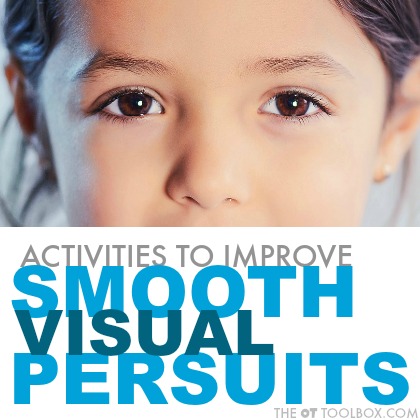

Colleen Beck, OTR/L has been an occupational therapist since 2000, working in school-based, hand therapy, outpatient peds, EI, and SNF. Colleen created The OT Toolbox to inspire therapists, teachers, and parents with easy and fun tools to help children thrive. Read her story about going from an OT making $3/hour (after paying for kids’ childcare) to a full-time OT resource creator for millions of readers. Want to collaborate? Send an email to contact@theottoolbox.com.
In The OT Toolbox Membership, you’ll find oculomotor tools that support visual tracking, smooth pursuits, and much more.


